英语语音知识及语言学知识
英语认知语言学

英语认知语言学英语认知语言学是研究英语语言的认知过程和结构的学科领域。
它涉及到对英语的理解、产生和使用的认知机制和规律进行探究。
本文将从语音、词汇、语法和语义等方面来介绍英语认知语言学的研究内容和方法。
一、语音认知语音是语言的基本要素之一,语音的认知过程对于我们理解和使用语言至关重要。
在英语认知语言学中,研究者通过分析声音的特点、语音单位和发音过程来探究语音的认知机制。
其中,声音的特点指的是语言中的音素、音节和音调等音位学要素;语音单位则是指在理解和使用语言时所处于注意的最小单位,比如音素的串联等;而发音过程则是指人们在理解和使用语言时生成声音的过程,包括声带、发音器官的协调等。
二、词汇认知词汇是语言的基本单位,研究词汇的认知过程有助于我们理解词汇的构成和用法。
英语认知语言学关注词汇的存储、识别和产生等过程。
在存储方面,研究者通过研究一词多义、词义辨析和词汇关联等现象来揭示词汇存储的机制;在识别方面,研究者研究人们在理解语言时如何通过语境和词汇特征等信息进行词汇的识别;在产生方面,研究者关注人们在表达时如何选择和使用恰当的词汇。
三、语法认知语法是指语言的句法结构,研究语法的认知过程可以帮助我们理解句子的结构和组织方式。
在英语认知语言学中,研究者关注句法的生成、解析和回避等过程。
在生成方面,研究者研究人们如何按照一定的规则和模式生成符合语法的句子;在解析方面,研究者研究人们如何通过语法知识和上下文信息进行句子的解析;在回避方面,研究者研究人们在语言使用过程中如何避免语法错误和困惑。
四、语义认知语义是指语言的意义系统,研究语义的认知过程有助于我们理解语言的意义和表达方式。
英语认知语言学关注词义、句义和篇义等层面的研究。
在词义方面,研究者研究词汇的意义构成和扩展,探究词义的认知过程和规律;在句义方面,研究者关注句子的意义生成和解释过程,研究语义角色和语义关联等现象;在篇义方面,研究者研究文本和篇章的意义结构和组织方式。
英语语言学知识点总结

英语语言学知识点总结
英语语言学是研究英语语言及其发展历史、语音、语法、词汇、语用等方面的学科。
以下是一些英语语言学的知识点总结:
1. 英语语音学:英语语音学主要研究英语的发音、声调、重音等语音现象。
其中,英语的发音规则主要包括元音、辅音和声调等方面的规则。
2. 英语语法学:英语语法学主要研究英语的语法结构和规则,包括句子结构、时态、语态、名词、形容词、副词等语法范畴。
3. 英语词汇学:英语词汇学主要研究英语的词汇构成、演化和使用情况,包括单词、词组和习语等方面的研究。
4. 英语语用学:英语语用学主要研究英语的语用功能和语境,包括语言交际、暗示、礼貌、语用失误等方面的研究。
5. 英语语音语调学:英语语音语调学主要研究英语的语音语调系统,包括英语的发音、声调、重音、节奏等方面的研究。
6. 英语文体学:英语文体学主要研究英语的文体风格和语言习惯,包括正式文体、口语文体、文学文体等方面的研究。
7. 英语词汇记忆学:英语词汇记忆学主要研究如何有效地记忆英语词汇,包括词汇记忆的方法、技巧和策略等方面的研究。
8. 英语跨文化交际学:英语跨文化交际学主要研究英语在不同文化中的交际和使用,包括跨文化沟通、文化差异、交际礼仪等方面的研究。
以上是一些英语语言学的重要知识点总结,不同学科之间的交叉
和融合也在不断推进着英语语言学的发展。
英语语言学 总结
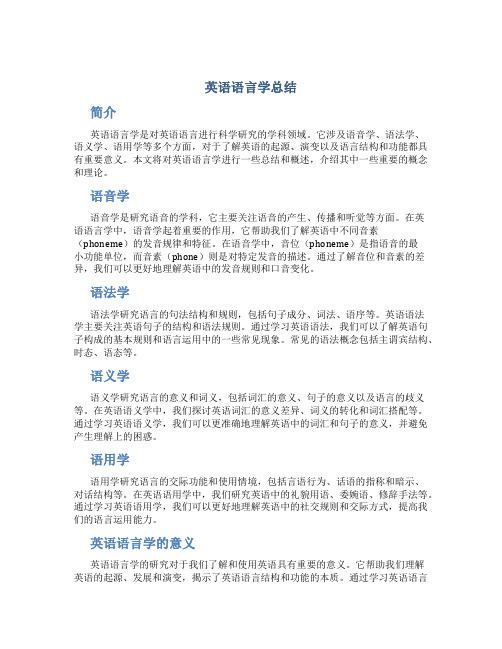
英语语言学总结简介英语语言学是对英语语言进行科学研究的学科领域。
它涉及语音学、语法学、语义学、语用学等多个方面,对于了解英语的起源、演变以及语言结构和功能都具有重要意义。
本文将对英语语言学进行一些总结和概述,介绍其中一些重要的概念和理论。
语音学语音学是研究语音的学科,它主要关注语音的产生、传播和听觉等方面。
在英语语言学中,语音学起着重要的作用,它帮助我们了解英语中不同音素(phoneme)的发音规律和特征。
在语音学中,音位(phoneme)是指语音的最小功能单位,而音素(phone)则是对特定发音的描述。
通过了解音位和音素的差异,我们可以更好地理解英语中的发音规则和口音变化。
语法学语法学研究语言的句法结构和规则,包括句子成分、词法、语序等。
英语语法学主要关注英语句子的结构和语法规则。
通过学习英语语法,我们可以了解英语句子构成的基本规则和语言运用中的一些常见现象。
常见的语法概念包括主谓宾结构、时态、语态等。
语义学语义学研究语言的意义和词义,包括词汇的意义、句子的意义以及语言的歧义等。
在英语语义学中,我们探讨英语词汇的意义差异、词义的转化和词汇搭配等。
通过学习英语语义学,我们可以更准确地理解英语中的词汇和句子的意义,并避免产生理解上的困惑。
语用学语用学研究语言的交际功能和使用情境,包括言语行为、话语的指称和暗示、对话结构等。
在英语语用学中,我们研究英语中的礼貌用语、委婉语、修辞手法等。
通过学习英语语用学,我们可以更好地理解英语中的社交规则和交际方式,提高我们的语言运用能力。
英语语言学的意义英语语言学的研究对于我们了解和使用英语具有重要的意义。
它帮助我们理解英语的起源、发展和演变,揭示了英语语言结构和功能的本质。
通过学习英语语言学,我们可以更好地掌握英语的发音、词汇、语法和语用等方面的知识,提高我们的英语语言能力。
此外,英语语言学还对翻译、教学、翻译和语言政策等领域有着重要的影响。
结论通过对英语语言学的总结,我们对英语语言的研究有了更深刻的认识。
(827)英语语言学知识

英语语言学是研究英语语言的科学领域,它涵盖了英语的语音、语法、词汇、句法、语义以及语用等方面的研究。
本文将从不同角度介绍英语语言学的基本概念、研究方法以及一些相关的重要理论。
一、语音学语音学是研究语音的科学,它关注的是语音的产生、传播和感知。
在英语语言学中,我们需要了解英语的音素和音系,即英语中的音位和音位之间的关系。
此外,我们还需要了解如何正确地发音,包括英语的元音和辅音。
二、语法学语法学是研究语言的结构和规则的科学,它关注的是语言中单词和句子的组成以及它们之间的关系。
在英语语言学中,我们需要了解英语的基本句型和句子成分的分类。
同时,我们还需要学习英语的时态、语态和语气等语法现象。
三、词汇学词汇学是研究词汇的科学,它关注的是词汇在语言中的作用和使用。
在英语语言学中,我们需要了解英语的词汇分类和词义的多样性。
同时,我们还需要学习如何正确地使用英语词汇,包括词汇的拼写和用法。
四、句法学句法学是研究句子结构和句子成分的科学,它关注的是句子的组成和句子成分之间的关系。
在英语语言学中,我们需要了解英语句子的基本结构和句子成分的分类。
同时,我们还需要学习如何正确地构造和分析英语句子。
五、语义学语义学是研究语言意义的科学,它关注的是语言中词汇和句子的意义。
在英语语言学中,我们需要了解词汇的意义和句子的意义,包括词语之间的关联和句子的推理。
同时,我们还需要学习如何正确地理解和表达英语的语义内容。
六、语用学语用学是研究语言使用的科学,它关注的是语言在社交交际中的实际运用。
在英语语言学中,我们需要了解英语的语用规则和语用策略,包括言语行为和话语的意图。
同时,我们还需要学习如何在不同语境下使用英语,以达到有效交流的目的。
《(827)英语语言学知识》是一篇关于英语语言学基本概念、研究方法和相关理论的文档。
通过学习语音学、语法学、词汇学、句法学、语义学和语用学等方面的知识,我们可以更好地理解和运用英语语言。
希望本文能够帮助读者对英语语言学有更深入的了解和认识。
英语语言学知识整理1

Chapter 1 Introduction语言学的定义:Linguistics is generally defined as the scientific study of language.问题:How do you interpret the following definition of linguistics: Linguistics is the scientific study of language?→It is a scientific study because it is based on the systematic investigation of linguistic data, conducted with reference to some general theory of language structure.What the linguist has to do “first, then, but”:①to observe and collect language facts and generalizations are made about them.②to formulate some hypotheses about the language structure.③to check the hypotheses thus formed repeatedly against the observed facts to fully prove their validity.The study of language as a whole is often called general linguistics. (普通语言学)问题: What are the major branches of linguistics? What does each of them study?→phonetics(语音学)→the study of sounds→phonology(音位学)→study how sounds are put together and used to convey meaning→morphology(形态学)→study the way in which symbols or morphemes are arranged and combined to form words.→syntax(句法学)→the study of rules of forming sentences →semantics(语义学)→the study of meaning→pragmatics(语用学)→ the context of language use Sociolinguistics(社会语言学):The studies of all these social aspects of language and its relation with society form the core of the branch.Psycholinguistics(语言心理学):Relate the study of language to psychologyApplied linguistics(应用语言学):In a narrow sense it refers to the application of linguistic theories and principles to language teaching, especially the teaching of foreign and second languages.Some important distinctions in linguistics:①prescriptive(规定性)/descriptive(描写性)②synchronic(共时)/diachronic(历时)③speech(口语)/writing(书面语)④langue(语言)/parole(言语)(the Swiss linguist F. de Saussure ——Course in General Linguistics)⑤competence(语言能力)/performance(语言应用)(the American linguist N. Chomsky)⑥traditional grammar (传统语法)/modern linguistics(现代语言学)问题:in what basic ways does modern linguistics differ from traditional grammar?①linguistics is descriptive while traditional grammar is prescriptive.②modern linguistics regards the spoken language as primary, not the written.③modern linguistics does not force languages into a Latin-based framework.问题:Is modern linguistics mainly synchronic or diachronic? Why?In modern linguistics, a synchronic (不考虑历史演进的, 限于一时的) approach seems to enjoy priority over a diachronic (探求现象变化的, 历时的) one.Because it is believed that unless the various states of a language in different historical periods are successfully studied, it would be difficult to describe the changes that have taken place in its historical development.Synchronic descriptions are often thought of as being descriptions of language in its current existence, and most linguistic studies are of this type.问题:For what reasons does modern linguistics give priority to speech rather than to writing?From the point of view of linguistic evolution, speech is prior to writing. The writing system of any language is always “invented”by its users to record speech when the need arises. Even in today’s world there are still many languages that can only be spoken but not written. Then in everyday communication, speech plays a greater role than writing in terms of the amount of information conveyed.Spoken language reveals more true features of human speech while written language is only the “revised”record of speech. And linguists’data for investigation and analysis are mostly drawn from everyday speech, which they regarded as authentic.语言的定义:Language is a system of arbitrary vocal symbols used for human communication.Design features of language(7个识别特征)①arbitrariness 任意性(at the syntactic level)②productivity 能产性,创造性Secondary units(底层结构 sounds)③duality 双层性Primary units (上层结构 units of meaning)④displacement 不受时空限制性(handle generalization and abstraction)⑤cultural transmission 文化传递性⑥interchangeability 互换性⑦convention 约定性Functions of language:三大主要功能:The descriptive functionThe expressive functionThe social functionRoman Jacobson(6种首要因素,结构主义语言学家)①speaker addresser→emotive 感情功能②addressee→conative 意动功能③context→referential所指功能④message→poetic 诗学功能⑤contact→phatic communion交感功能⑥code→metalinguistic 元语言功能Other functions:①phatic function 问候功能②informative f. 信息功能③interrogative f. 询问功能④expressive f. 表达功能⑤evocative f. 感染功能⑥directive f. 指令功能⑦performative f. 行使(权力)功能M.A.K. Halliday①ideational②interpersonal(indicate/establish/maintain/social relationships)③textual问题:How is Saussure’s distinction between langue and parole similar to Chomsky’s distinction between competence and performance?The distinction between langue and parole was made by Saussure, langue is abstract; it is not the language people actually use. Parole is concrete; it refers to the naturally occurring language events. Langue is relatively stable; it does not change frequently, while parole varies from people to people, and from situation to situation.The distinction between competence and performance proposed by the American linguists Chomsky, competence is a deal user’s knowledge of the rules of his language, and the performance is the actual realization of this knowledge in linguisticcommunication. Imperfect performance is caused by social and psychological factors.Saussure makes this distinction in order to single out one aspect of language for serious study. In his opinion, parole is simple a mass of linguistic facts, too varied confusing for systematic investigation, and that linguistics should do is to abstract langue from parole, i.e., to discover the regularities governing the actual use of language and make them the subjects of study of linguistics.Similar to Saussure, Chomsky thinks what linguists should study is the ideal speaker’s competence, not his performance, which is too haphazard to be studied.问题:What are the main features of human language that have been specified by C. Hockett to show that it is essentially different from animal communication system?①arbitrariness 任意性(at the syntactic level)②productivity 能产性,创造性Secondary units(底层结构 sounds)③duality 双层性Primary units (上层结构 units of meaning)④displacement 不受时空限制性(handle generalization andabstraction)⑤cultural transmission 文化传递性⑥interchangeability 互换性⑦convention 约定性Chapter 2 PhonologyPhonetics: (语音学)①the study of the phonic medium of language②look at speech sounds from 3 distinct but related points of view.Ⅰstudy the sounds from the speaker’s point of view→articulatory phonetics(发音语音学)Ⅱlook at the sounds from the hearer’s point of view→auditory phonetics(听觉语音学)Ⅲstudy the way sounds travel by looking at the sound waves →acoustic phonetics(声学语音学)③study how sounds are produced, transmitted and perceived. Organs of speech:⒈three important areas①The pharyngeal cavity→the throat② the oral cavity→the mouth③ the nasal cavity→the nose⒉The pharyngeal cavity→windpipe/glottis/larynx/vocalcords⒊the oral cavity→tongue/uvula/soft palate(velum)/hard palate/teeth ridge(alveolus)/teeth/lipsInternational Phonetic Alphabet (IPA)①diacritics 附加符号②broad transcription(宽式标音)→the transcription with letter-symbols only③narrow transcription(严式标音)→the transcription withletter-symbols together withthe diacriticsClassification of English speech sounds①two broad categories of speech sounds in English: Vowels/consonants②two ways to classify the English consonants: In terms ofmanner ofarticulationIn terms of place of articulation③In terms of manner of articulation:Stops/fricatives/affricates/liquids/nasals/glides④In terms of place of articulation:Bilabial/labiodental/dental/alveolar/palatal/velar/glottal⑤Classification of English vowels⒈criteria :(monophthongs)单元音The position of the tongue in the mouth: front/central/back The openness of the mouth: close vowels/semi-closevowels/semi-openvowels/open vowels The shape of the lips: unrounded/roundedThe length of the vowels: tense/lax⒉diphthongs 双元音/ ei // ai // au // əu // ɔi // iə //εə// uə /Phonology 音韵学,语音体系Difference of phonology and phonetics:①Phonetics is interested in all the speech sounds used in allhuman languages.②Phonology aims to discover how speech sounds in a languageform patterns and how these sounds are used to convey meaning in linguistic communication.Phone(音素): A phone is a phonetic unit or segment. Phoneme(音位): It is a phonological unit; it is a unit that is of distinctive value. It is an abstract unit. It is not any particular sound, but rather it is represented or realized by a certain phone in a certain phonetic context.Allophone(音位变体): The different phones which can represent a phoneme in different phonetic environments are called the allophones of that phoneme.Phonemic contrast(音位对立)Complementary distribution(音位变体的互补分布)Minimal pairs(最小对立体):含音位的单词的全部音标Minimal set(最小对立集):is used to find the important sounds in language.Phonological Analysis(音位分析)Principle: certain sounds cause changes in the meaning of a word or phase, whereas other sounds do not.Phonetically similar sounds:描述音位关系Free variants: 音位的自由变体The difference of pronouncing a sound caused by dialect, habit, individual difference or regional differences instead of by any distribution rule.Some rules in phonology①sequential rules: 序列规则If a word begins with a / l / or a / r /, then the next sound must be a vowel.If three consonants should cluster together at the beginning of a word, the combination should obey the following three rules:The first phoneme must be / s /The second phoneme must be / p / / t / / k /The third phoneme must be / l // r // w /②assimilation rule:同化规则③deletion rule:省略规则Suprasegmental features 超音段特征≠超音段(比音位更大的语言单位)①stress(单词,句子层面):the location of stress in English distinguishes meaning.Syllable音节:A syllable nucleus (often a vowel) with optional initial and final margins (often consonants)单音节词多音节词英语单词都有重读音位学中,单词由音节构成,音节由音位构成。
英语语言学

英语语言学语言学普遍被定义为对语言进行科学研究,他试图回答如下基本问题:什么是语言,语言是如何运作的。
主要包括了普通语言学,语音学,音位学,形态学,句法学,语义学,语用学等部分。
本文重点介绍了语音学,音位学和形态学,并提出了学习中一些自己的想法。
一语音学口语交际的媒介是语音(speech sounds),也就是说人们通过声道(vocal track)发出的音来表达意义。
这种对语音的研究被叫做语音学(phonetics)。
语音学主要包括了如下内容。
发音器官语音是由各种发音器官(speech organ)而产生的。
因此,正确理解语音需要掌握相关的发音系统知识。
人的发音器官包含在咽腔,口腔,鼻腔三个区域中。
英语语音的表征方法通常我们使用国际音标来代表语音,也就是我们常说的宽式音标。
在描写语音时,为了体现语音的细微差异,语言学使用更为详细的标音方法,有时被称为严式记音(narrow transcription)。
在窄式记音中,一些较小符号经常被附加在音标上,如鼻化符[ ˘ ]、重音符[ˊ]等。
这些改变音值的较小记号叫做变音符(diacritic)。
英语语音的分类英语语音主要分为元音(vowels)和辅音(consonants) 两类。
他们的主要区别是:发元音时,发音器官不形成阻碍,气流可以畅通无阻地经口腔或鼻腔流出;发辅音时,发音器官某一部位形成阻碍,气流必须克服阻碍才能通过。
辅音可以根据发音部位(places of articulation)、发音方式(manners of articulation)进行分类和描写。
在发元音时,没有类似发辅音时产生的气流受阻的现象,因此,描写元音不能沿用描写辅音的方法。
语言学家通常依据以下三个原则对元音进行描写:(1)嘴的张合度; (2)舌头抬升的部位---- 前、中、后;(3)唇的开合度——唇的圆或展的不同程度;二音位学音位学(phonology)和语音学一样都是对语音的研究,但两者研究的视角却不同。
单词发音知识点总结图表

单词发音知识点总结图表
一、声音和语音
声音是指物体振动时产生的声波,而语音是指人类利用声音来进行交流的符号系统。
语音可以通过发音来表达出来,而发音则是通过调整声道、舌头和唇部等部位来产生不同的音频。
二、语音的分类
语音可以根据不同的属性进行分类,其中包括元音、辅音、浊音和清音等。
元音是由声带自由振动产生的音,辅音则是由声带振动受到阻碍而产生的音。
而浊音和清音则是根据声带振动的有无来进行区分的。
三、英语单词的发音
英语单词的发音遵循一定的规则,其中包括重读音节和非重读音节的发音规律,同时还有一些不规则单词的发音规律。
学习正确的发音对于提高英语听力和口语水平具有非常重要的意义。
四、发音知识点总结
1. 元音和辅音的发音规律
元音通常分为长元音和短元音,长元音的发音时间更长,而短元音的发音时间更短。
辅音则可以根据吐气的强弱和振动的有无进行分类。
2. 单词重读音节的发音规律
英语中的单词通常会有一个或多个重读音节,重读音节和非重读音节的发音方式也是不同的。
重读音节通常会发出更加清晰和明显的声音,而非重读音节则会较为模糊和不清晰。
3. 不规则单词的发音规律
英语中还存在一些不规则的单词,它们的发音规律通常没有规律可循,需要通过大量的阅读和听力练习来进行掌握。
这些不规则的单词通常是由外来语言或历史演变而来,因此它们的发音规律也十分复杂。
综上所述,发音知识是学习语言的重要组成部分,掌握正确的发音规律对于提高语言水平具有非常重要的意义。
希望大家可以通过不断的练习和实践来提高自己的发音能力,从而更好地掌握英语这门语言。
英语语言学大全
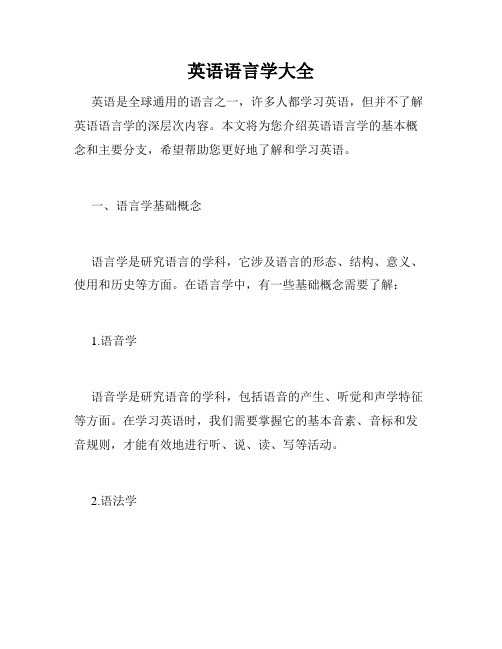
英语语言学大全英语是全球通用的语言之一,许多人都学习英语,但并不了解英语语言学的深层次内容。
本文将为您介绍英语语言学的基本概念和主要分支,希望帮助您更好地了解和学习英语。
一、语言学基础概念语言学是研究语言的学科,它涉及语言的形态、结构、意义、使用和历史等方面。
在语言学中,有一些基础概念需要了解:1.语音学语音学是研究语音的学科,包括语音的产生、听觉和声学特征等方面。
在学习英语时,我们需要掌握它的基本音素、音标和发音规则,才能有效地进行听、说、读、写等活动。
2.语法学语法学是研究语言结构和组织的学科,有时也称为句法学。
它研究语言的词类、句子结构、语法关系等方面。
通过学习英语的语法,我们可以正确使用语言,避免出现语法错误。
3.语义学语义学是研究语言意义的学科,它探究词汇、短语和句子意义的形成和变化。
在英语学习中,我们需要理解单词和短语的意义,以及句子的含义,以便正确理解和表达内容。
4.语用学语用学是研究语言使用的学科,包括口语和书面语言的使用场合、对话方式、说话人的语言目标和对听者的影响等方面。
在英语学习中,我们需要了解不同场合和对象的语言使用规范,以便与人交流时更加得心应手。
二、英语语言学的主要分支除了以上基础概念外,英语语言学还有一些重要的学术分支,能够帮助我们更深入地了解和掌握英语。
1.语音学英语语音学探究的是英语中的音素、音标和发音规则等方面,以及与其他语音系统的比较和差异。
2.语法学英语语法学研究的是英语的句法结构、语法关系和句子意义等方面,以及与其他语言的比较和翻译问题。
3.词汇学英语词汇学是研究英语词汇的学科,包括单词的来源、组成和意义等方面,以及与其他语言的比较和词汇翻译问题。
4.语用学英语语用学研究的是英语在语言使用中的实际应用,包括语言交际、言语行为、语境和语言目的等方面。
5.文本语言学英语文本语言学是研究英语文本的结构、组织和语言特点等方面的学科,包括语篇分析和修辞分析等内容。
英语语言学知识

英语语言学知识English:1. What is the study of English language called?The study of English language is called English linguistics or English language studies.2. What are the main branches of English language studies?The main branches of English language studies include phonetics, phonology, morphology, syntax, semantics, pragmatics, and sociolinguistics.3. What is phonetics?Phonetics is the study of the physical sounds of human speech, including the production and perception of speech sounds.4. What is phonology?Phonology is the study of the sound patterns of a language, including the way sounds are organized and used in the language.5. What is morphology?Morphology is the study of the structure and formationof words in a language, including the ways in which words are formed and the relationships between different forms ofa word.6. What is syntax?Syntax is the study of the structure and formation of sentences in a language, including the rules and principles that govern how words are combined to form grammatical sentences.7. What is semantics?Semantics is the study of the meaning of words, phrases, and sentences in a language, including how meaning is constructed and interpreted in communication.8. What is pragmatics?Pragmatics is the study of the use of language in context, including how language is used to convey meaning and achieve communicative goals in different social and cultural settings.9. What is sociolinguistics?Sociolinguistics is the study of the relationship between language and society, including how language varies and changes in different social and cultural contexts.10. What are the major theories of language acquisition?The major theories of language acquisition include behaviorist theories, nativist theories, interactionist theories, and cognitive theories.中文:1. 英语语言学的研究叫什么?英语语言学的研究叫做英语语言学或英语语言研究。
英语语言学超强总结
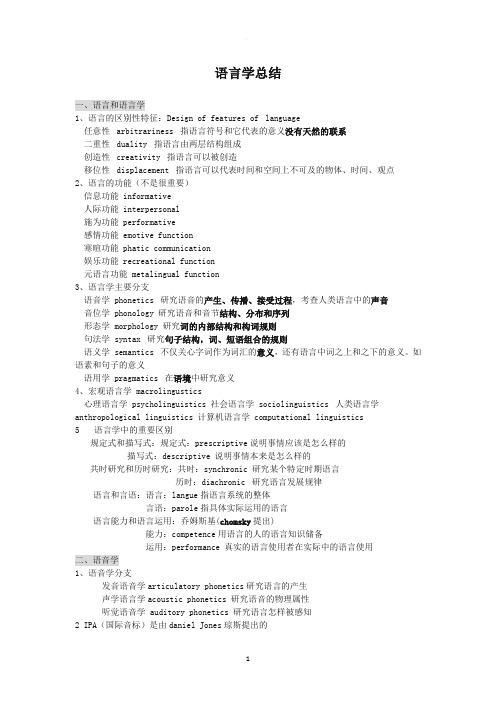
语言学总结一、语言和语言学1、语言的区别性特征:Design of features of language任意性 arbitrariness指语言符号和它代表的意义没有天然的联系二重性 duality指语言由两层结构组成创造性 creativity指语言可以被创造移位性 displacement指语言可以代表时间和空间上不可及的物体、时间、观点2、语言的功能(不是很重要)信息功能 informative人际功能 interpersonal施为功能 performative感情功能 emotive function寒暄功能 phatic communication娱乐功能 recreational function元语言功能 metalingual function3、语言学主要分支语音学 phonetics研究语音的产生、传播、接受过程,考查人类语言中的声音音位学 phonology 研究语音和音节结构、分布和序列形态学 morphology 研究词的内部结构和构词规则句法学 syntax研究句子结构,词、短语组合的规则语义学 semantics不仅关心字词作为词汇的意义,还有语言中词之上和之下的意义。
如语素和句子的意义语用学 pragmatics在语境中研究意义4、宏观语言学 macrolingustics心理语言学 psycholinguistics 社会语言学 sociolinguistics人类语言学anthropological linguistics 计算机语言学 computational linguistics5语言学中的重要区别规定式和描写式:规定式:prescriptive说明事情应该是怎么样的描写式:descriptive 说明事情本来是怎么样的共时研究和历时研究:共时:synchronic 研究某个特定时期语言历时:diachronic研究语言发展规律语言和言语:语言:langue指语言系统的整体言语:parole指具体实际运用的语言语言能力和语言运用:乔姆斯基(chomsky提出)能力:competence用语言的人的语言知识储备运用:performance 真实的语言使用者在实际中的语言使用二、语音学1、语音学分支发音语音学articulatory phonetics研究语言的产生声学语言学acoustic phonetics 研究语音的物理属性听觉语音学 auditory phonetics 研究语言怎样被感知2 IPA(国际音标)是由daniel Jones琼斯提出的1、最小对立体minimal pairs2、音位 phoneme3音位变体 allophones4互补分布 complementary distribution5自由变体 free variation6区别特征 distinctive features7超音段特征 suprasegmental feature音节 syllable 重音stress 语调tone 声调intonation四形态学1词的构成语素morpheme 自由语素free morpheme 粘着语素bound morphemeRoot 词根词缀affix词干stem屈折词汇和派生词汇 inflectional affix and derivational affix2特有的词汇变化lexical change proper新创词语invention混拼词blending缩写词abbreviation首字母缩写词 acronym逆构词汇back-formation例:editor—edit类推构词analogiacal creation 例:work-worked,,slay-slayed外来词 borrowing五句法学1范畴category数number性gender格case时tense体aspect 一致关系concord支配关系govenrment2 结构主义学派the structure approach组合关系 syntagmatic relation词和词组合在一起聚合关系 paradigmatic 具有共同的语法作用的词聚在一起结构和成分 construction and constituents :句子不仅是线性结构liner structure 还是层级结构hierarchical structure (句子或短语被称为结构体,而构成句子或短语即结构体的称为成分)3直接成分分析法 immediate constitutional analysis指把句子分成直接成分-短语,再把这些短语依次切分,得到下一集直接成分,这样层层切分,直到不能再分4向心结构和离心结构endocentric and exocentric constructions 向心:指一个结构中有中心词,例an old man ,中心为man离心:指结构中没有明显的中心词。
语言学知识(专八)

语言学知识语言学是对语言的系统研究,对于一个学习英语的人来说,应该懂一点语言学的知识,它可以在理论上对学习语言有指导作用,有助于更好的学习语言,下面介绍一点语言学知识。
I. Introduction1. What is LanguageLanguage is a system of arbitrary vocal symbols used for human communication.2. What is Linguistics(语言学)Linguistics is the scientific study of language.3.Some Basic Distinctions(区分) in Linguistics3.1 Speech and WritingOne general principle(原则) of linguistic analysis is the primacy of speech over writing. Writing gives language new scope(范畴) and uses that speech does not have.3.2 Descriptive(描述性) or Prescriptive(说明性)A linguistic study is descriptive if it describes and analyses facts observed; it is prescriptive if it tries to lay down rules for "correct" behavior.3.3 Synchronic(共时) and Diachronic(历时) StudiesThe description of a language at some point in time is a synchronic study and The description of a language as it changes through time is a diachronic study.3.4 Langue(语言) and Parole(言语)This is a distinction made by the Swiss linguist F.De Saussure (索绪尔)early last century. langue refers to the abstract linguistic system shared by all the members of a speech community and parole refers to the actualized(实际的) language, or realization of langue.3.5 Competence(能力)and Performance(行为)Competence is the ideal language user's knowledge of the rules of his language. Performance is the actual realization of this knowledge in utterances(发声).4.The Scope of LinguisticsGeneral linguistics is the study of language as a whole.Phonetics(语音学) is the branch of linguistics which studies the characteristics of speech sounds and provides methods for their description, classification and transcription.Phonology(音韵学) is the branch of linguistics which studies the sound patterns of languages.Morphology(词法) is the branch of linguistics which studies the form of words.Syntax(句法) is the branch of linguistics which studies the rules governing the combination of words into sentences.Semantics(语义学) is the branch of linguistics which studies the meaning of language.Applied linguistics(应用语言学) is the study of the teaching of foreign and second languages.Sociolinguistics is the study of the relationship between language and society.Psycholinguistics is the study of the relationship between language and the mind.Historical Linguistics(历史语言学) is the study of language changes.Anthropological linguistics(人文语言学) uses the theories and methods of anthropology to study language variation and language use in relation to the cultural patterns and beliefs of man.Neurolinguistics(神经语言学) studies the neurological basis of language development and use in human beings.Mathematical linguistics(数学语言学) studies the mathematical features of language, often employing models and concepts of mathematics.Computational linguistics(计算语言学) is an approach to linguistics in which mathematical techniques and concepts(概念) are applied, often with the aid of a computer.II. Phonetics(语音学)1. scope of phoneticsSpeech sounds may be studied from different angles, thus we have at least three branches of phonetics:Articulatory phonetics(发音语音学)we may examine the way in which a speech sound is produced to discover which vocal organs are involved and how they coordinate(协调)in the process.Auditory phonetics (听觉语音学)we may look into the impression a speaker makes on the hearer as mediated(调节)by the ear, the auditory nerve(神经)and the brain.Acoustic phonetics (声学语音学)we study the physical properties of speech sounds, as transmitted(传送)between mouth and ear.2. The vocal organsThe vocal organs may be viewed as consisting of three parts, the initiator of the air-stream,(气流发生器官)the producer of voice(声音发生器官)and the resonating cavities.(声音共振器官)3. Consonants(辅音)Places of articulation(发音部位): bilabial,(双唇)Labiodentals,(唇齿)dental,(齿)alveolar,(齿龈)retroflex,(卷舌)palate-alveolar,(上齿龈)palatal,(上颚)velar,(软腭)uvular,(小舌)glottal(声门)Manners of articulation: plosive,(暴破)nasal,(鼻音)trill,(颤音)lateral,(边音)fricative,(摩擦)approximant,(近似音)affricate(破擦)4. Vowels (元音)The classification of vowels: the height of tongue raising (high, mid, low), the position of the highest part of the tongue(front, central, back), and the degree of lip rounding(rounded, unrounded)III. Phonology(音韵学)1. phonemes(音素):a distinctive(有区别的)sound in a language.2. Allophones(音位变体):The nondistinctive sounds are members of the same phoneme.3. Minimal pairs(最小对立体):word forms which differ from each other only by one sound.4. Free variation (自由变异):If two sounds occurring in the same environment(环境), they does not produce a different word form, but merely a different pronunciation of the same word.5. Complementary distribution(补充分类):Not all the speech sounds occur in the same environment. When two sounds never occur in the same environment6.Suprasegmental phonology(超音段音位):the study of phonological properties(性质)of units lager than the segment-phoneme. They are syllable(音节),stress,(重音)word stress, sentence stress. pitch (音调)and intonation(语调).IV. Morphology(词法)1. inflection(构形法):the grammatical relationships through the addition of inflectional affixes.(屈折词缀)2. Word-formation(构词):the processes(过程)of word variations signaling lexical relationships.(表明词法关系)They are compound(合成)and derivation (派生).3. Morpheme(词素):the smallest unit in terms of relationship between expression and content.4. Allomorph(同质异象变体):some morphemes have considerable variation, for instance, alternate shapes or phonetic forms.5. Types of morphemes: They are roots,(词根)affix(词缀)and stem(词干).6. Lexicon(语言词汇):in its most general sense, is synonymous with vocabulary.7. Closed-class words(封闭性)and open-class words(开放性):the former whose membership is fixed or limited and the latter whose membership is in principle(实际上)indefinite or unlimited.8. Word class(词性):It displays a wider range of more precisely defined classes.9. Lexeme(词位):the smallest unit in the meaning system of a language that can be distinguished from other smaller units.10. Idiom(习语,成语):Most phrasal lexemes are idioms. It is especially true for a sequence of words(词序)which is semantically(语义上)and often syntactically(句法上)restricted.(限制)11. Collocation(搭配):the habitual(习惯的)co-occurrences (同时出现)of individual lexical items.V. Syntax (句法)1. Positional relation or word order(词序):the sequential(顺序)arrangement of wordsin a language.2. Construction or constituent (句子结构):the overall process of internal (内部)organization of a grammatical unit .3. Syntactic function(句法功能):the relationship between a linguistic form and other parts of the linguistic pattern in which it is used. The names of functions are expressed in terms of subjects, objects, predicates, modifiers,(修饰语)complements(补语), etc.4. Category(范畴):It refers to classes and functions in its narrow sense, e.g. noun, verb, subject, predicate, noun phrase, verb phrase, etc. The categories of the noun include number, gender, case and countability.5. Phrase: a single element of structure containing more than one word, and lacking the subject-predicate structure typical of clause.6. Clause: a group of words with its own subject and predicate, if it is included in a larger sentence.7. Sentence: It is the minimum part of language that expresses a complete thought.VI. Semantics1. Conceptualism or mentalism (概念主义):Following F. De Saussure(索学尔)'s "sign" theory, the linguistic sign is said to consist of a signifier (所指)and signified(被指), i.e., a sound image and a concept, liked by a psychological(心理的)"associative" bond.(相关了解)2. Mechanism(机械主义):Some linguists, Bloomfield,(布鲁费尔德)for example, turned to science to counter(反)-act the precious theories and this leads to what call the mechanistic approach(方法). The nature of this theory has nothing to do with the scientific study of mental phenomena.(智力现象)3. Contextualism (语境主义):It is based on the presumption(假定)that one can derive meaning from or reduce it to observable context.4. Behaviorism (行为主义):Behaviourists attempt to define (定义)the meaning of a language form as "the situation(情景)in which the speaker utters(说话)it and the response(反应)it calls forth in the hearer."5. functionalism (功能主义):functionalists as represented (代表)by the Prague school(布拉格学派)linguists and neo-Firthian (新弗斯)linguists, approach the problem from an entirely new orientation(方法). They argue(争辩)that meaning could only be interpreted (解释)from its use or function in social life.6. Sense relationships: While reference deals with the relationship between the linguistic elements, words, sentences, etc.,and the non-linguistic world of experience, sense relates to the complex system of relationships that hold between the linguistic elements themselves. They include synonymy(同义词),antonymy(反义词),hyponymy(下层次)Polysemy(一词多义)and Homonymy (同音异义词)7. Semantic analysis: It includes 1) componential(成分)analysis which defines the meaning of a lexical element in terms of semantic components.(意义成分)2) predication (表述)analysis in which the meaning of a sentence is not merely the sum of the meanings of the words which compose it. 3) relational components in which the semantic analysis of some words presents a complicated picture, because they show relations between two and perhaps more terms.VII. Language variation (语言变化)1. Lexical change(词汇的变化):changes in lexis.2. Invention: (新造词)new entities.3. Compounding合成词)New words are sometimes constructed by combining two old words.4. Blending: (混合词):It is a relatively complex form of compounding, in which two roots are blended by joining the initial part of the first root and the final part of the second root, or by joining the initial parts of the two roots.5. Abbreviation or clipping缩写)A new word is created by cutting the final part or cutting the initial part.6. acronym取首字母的缩写词)It is made up from the first letters of the name of an organization, which has a heavily modified (修饰)headword.7. metanalysis再分化)It refers to a process through which a division is made where there were note before.8. Back-formation逆构词)It refers to an abnormal(非正常)type of word-formationwhere a shorter word is derived by deleting(去掉)an imagined affix from a longer form already present in the language.9. Analogical creation:(类比造词)It can account for(说明)the co-existence of two forms, regular and irregular, in the conjugation(结合)of some English verbs.10. Borrowing(借用):English in its development has managed to widen her vocabulary by borrowing words from other languages.11. Phonological change(音变):It is related to language variation in the phonological system of language. It includes loss,(省音)addition,(加音)assimilation,(同化)dissimilation.(异化)12. Grammatical change: Changes in both morphology(词法)and syntax(句法)are listed under this heading.13. Semantic change:(语义变化)It includes broadening,(语义扩大)narrowing,(语义缩小)meaning shift,(意义转化)class shift(词性转换)and folk etymology.(词源变化)14. Orthographic change :(正字法)Changes can also be found at the graphetic level.[文档可能无法思考全面,请浏览后下载,另外祝您生活愉快,工作顺利,万事如意!]。
英语语言学复习资料整理

语言学重要概念梳理1. Language (语言) is a system of arbitrary vocal symbols used for human communication.2. Linguistics(语言学)is generally defined as the scientific study of language.3. General linguistics(普通/一般语言学) The study of language as a whole is often called general linguistics.4. Phonetics(语音学) the study of sounds used in linguistic communication led to the establishment of phonetics.5. Phonology(语音体系) how sounds are put together and used to convey meaning in communication.6. Morphology(形态学) these symbols are arranged and combined to form words has constituted the branch of study called morphology.7. Syntax(句法学) then the combination of words to form grammatically permissible sentences in languages is governed by rules. The study of these rules constitutes a major branch of linguistic studies called syntax.8. Semantics(语意学) the study of meaning is known as semantics.9. Pragmatics(语用学) when the study of meaning is conducted, not in isolation, but in the context of language use, it becomes another branch of linguistic study called pragmatics.10. Phone(音素) is a phonetic unit or segment. The speech sounds we hear and produce during linguistic communication are all phones.11. Phoneme(音位)is a phonological unit; it is a unit that is of distinctive value. It is an abstract unit. It is not any particular sound, but rather it is represented or realized by a certain phone in a certain phonetic context.12. Allophones(音位变体) the different phones which can represent a phoneme in different phonetic environments are called the allophones.13. IPA(International Phonetic Alphabet国际音标) It’s a standardized and internationally accepted system of phonetic transcription. The basic principle of the IPA is using one letter selected from major European languages to represent one speech sound.14. Diacritics(变音符) it is a set of symbols which are added to the letter-symbols to bring out the finer distinctions.15.broad transcription(宽式标音) one is the transcription with letter-symbols only.16.narrow transcription(严式标音) the other is the transcription with letter-symbols together with the diacritics.17. open class words(开放类词)In English , open class words are nouns, verbs, adjectives and adverbs. We can regularly add new words to these classes.18. closed class words(封闭类词) In English , closed class word are conjunctions, prepositions, articles and pronouns. New words are not usually added to them.19. Morpheme(词素) the most basic element of meaning is traditionally called morpheme.20. bound morpheme(黏着词素) morphemes which occurs only before other morphemes. They cannot be used alone.21. free morpheme(自由词素)it is the morphemes which can be used alone.22. suprasegmental features(超音段特征) the phonemic features that occur above the level of the segments are called suprasegmental features.23. Category(范畴) it refers to a group of linguistic items which fulfill the same or similar functions in a particular language such as a sentence ,a noun phrase or a verb.24. Phrases(短语) Syntactic units that are built around a certain word category are called phrases.1. Three distinct of phonetics(语音学的三个分支?)Articulatory phonetics发音语音学; auditory phonetics听觉语音学; acoustic phonetics声光语音学.2. Main features of language(语言的主要特征?)Language is a system. Language is arbitrary. Language is vocal. Language is human-specific.3. Synchronic vs. diachronic(共识语言学与历史语言学的区别?)Language exists in time and changes through time. The description of a language at some point of time in history is a synchronic study; the description of a language as it changes through time is a diachronic study. A diachronic study of language is a historical study; it studies the historical development of language over a period of time.4. Speech and writing (言语与文字的区别?)Speech and writing are the two major media of linguistic communication. From the point of view of linguistic evolution, speech is prior to writing. The writing system of any language is always “invented” by its users to record speech when the need arises. Then in everyday communication, speech plays a greater role than writing in terms of the amount of information conveyed, speech is always the way in which every native speaker acquires his mother tongue, and writing is learned and taught later when he goes to school. Written language is only the “revised” record of speech.5. What are the branches of linguistic study?(语言学研究领域中的主要分支有哪些?)1) sociolinguistics; 2) psycholinguistics; 3)applied linguistics and so on.6. Traditional grammar and modern linguistics(传统语法与现代语言学的区别?)Firstly, linguistics is descriptive while traditional grammar is prescriptive.Second, modern linguistics regards the spoken language as primary, not the written. Traditional grammarians, tended to emphasize, maybe over-emphasize, the importance of the written word.Modern linguistics differs from traditional grammar also in that it does not force languages into a Latin-based framework.7. Prescriptive vs. descriptive (语言学中描写性与规定性的特征是什么?)Prescriptive and descriptive represent two different types of linguistic study. If a linguistic study aims to describe and analyze the language people actually use, it is said to be descriptive; if the linguistic study aims to lay down rules for “correct and standard” behavior in using language, it is said to be prescriptive.8. Design features of language (语言的识别特征?)Arbitrariness随意性,productivity生产性, duality 二重性, displacement 不受时空限制的特征, cultural transmission 文化传递系统.9. Competence and performance (语言能力与语言行为的区别?)Competence is defined as the ideal user’s knowledge of the rules of his language, and performan ce the actual realization of this knowledge in linguistic communication. Chomsky looks at language from a psychological point of view and to him competence is a property of the mind of each individual.10. Organs of speech (发音器官)Pharyngeal cavity—the throat, oral cavity—the mouth, nasal cavity—the nose.11. Word-level categories(决定词范畴的三个标准)To determine a word’s category, three criteria are usually employed, namely meaning, inflection and distribution.1. Some rules in phonology(音位学规则)sequential rules(序列规则);assimilation rule (同化规则) ;deletion rule(省略规则)。
英语语言学知识点整理
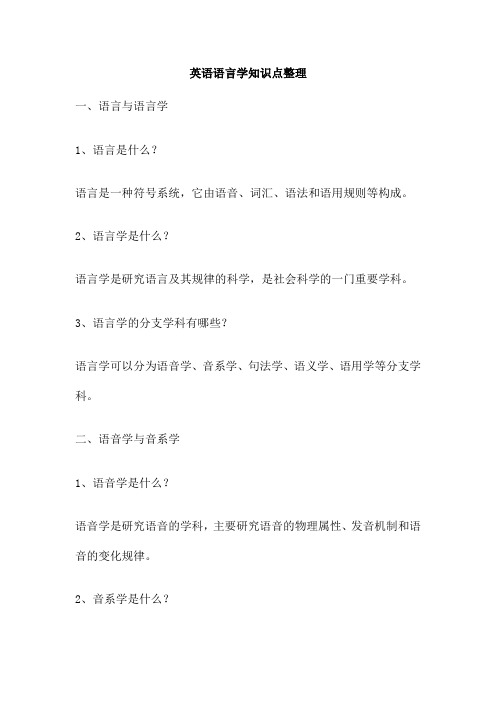
英语语言学知识点整理一、语言与语言学1、语言是什么?语言是一种符号系统,它由语音、词汇、语法和语用规则等构成。
2、语言学是什么?语言学是研究语言及其规律的科学,是社会科学的一门重要学科。
3、语言学的分支学科有哪些?语言学可以分为语音学、音系学、句法学、语义学、语用学等分支学科。
二、语音学与音系学1、语音学是什么?语音学是研究语音的学科,主要研究语音的物理属性、发音机制和语音的变化规律。
2、音系学是什么?音系学是研究语言的音系系统的学科,它的是语言的音位、音素、音节、语素等基本单位以及它们之间的组合关系和变化规律。
3、语音和音系的关系是什么?语音是音系的具体表现形式,而音系则是语音的基础和框架。
语音受到个人的发音和语境的影响,而音系则是一种抽象的概念,它是语言社团所共同遵守的规则。
三、句法学1、句法学是什么?句法学是研究句子的结构和规律的学科。
它主要的是词类、句子成分的构成和它们之间的组合关系。
2、句法学的核心概念有哪些?句法学的核心概念包括:词类、句子成分、句法关系、句型等。
3、常见的句法结构有哪些?常见的句法结构包括:简单句、复合句、并列句、复合并列句等。
四、语义学1、语义学是什么?语义学是研究语言意义的学科,主要研究词义、短语意义、句子意义和语篇意义等。
2、语义的分类有哪些?语义可以分为词汇意义、语法意义和语用意义。
词汇意义是指词汇的基本意义,语法意义是指词汇在句子中的组合关系和变化规律,语用意义是指词汇在特定语境中的特殊意义。
3、语义关系有哪些?语义关系包括:同义关系、反义关系、上下义关系等。
同义关系是指两个或多个词义相同或相似的词语之间的关系,反义关系是指两个或多个词义相反的词语之间的关系,上下义关系是指一个词所表达的概念是另一个词所表达的概念的一部分。
语言学知识点整理语言学是一门研究人类语言的学科,涉及语言的各个方面,包括语言的结构、使用、习得和进化等。
以下是一些常见的语言学知识点:1、语言与言语:语言是指一种符号系统,是人们用来表达思想、情感和意愿的工具。
英语语言学语言学知识点

英语语言学语言学知识点语言学是一门研究语言的学科。
它涵盖了多个领域,包括语音学、语法学、语义学、语用学和语言变化等。
下面将简要介绍一些语言学的重要知识点。
一、语音学(Phonetics)语音学是研究语音的学问。
它关注语音的产生、传播和感知等方面。
在语音学中,语音被分为音素(phoneme)和音位(allophone)。
音素是语言中最小的语音单位,可以在语言中起到区分意义的作用。
而音位是相同意义的不同实现方式,即同一音素的不同发音形式。
在语音学中,还有一些重要概念,如元音(vowel)和辅音(consonant)。
元音是语音学中最基本、最重要的音类,它们的发音不受任何阻塞或摩擦的干扰。
而辅音则需要通过口腔或喉头的阻塞或摩擦才能产生。
二、语音语调学(Phonology)语音语调学是研究语音和语调现象的学问。
它研究语音和语音的组织方式和相互关系。
在语音语调学中,音位和音位组成规则是核心概念之一、音位组成规则决定了在一个语言中哪些音位可以成为合法的音节。
此外,在语音语调学中还有音变(phonological variation)的概念。
音变指的是在其中一种语言中,一个特定音位的发音方式会随着不同的语音环境而发生变化的现象。
音变是语言变化的一种重要表现。
三、语法学(Grammar)语法学是研究语言的结构和规则的学问。
在语法学中,句子是一个重要的研究对象。
句子结构可以划分为短语(phrase)和句子成分(sentence constituents),如名词短语、动词短语和介词短语等。
语法学还涉及到句子的成分顺序和组成规则。
在语法学中,句法树(syntactic tree)是一种图形表示方式,用于描述句子的结构。
句法树由句子的各个成分和它们之间的关系构成。
四、语义学(Semantics)语义学是研究词汇和句子意义的学问。
它关注词语和句子的语义性质、意义的产生机制以及词义的转换等。
在语义学中,可以通过语义角色(semantic role)和逻辑关系(logical relation)来描述词语和句子之间的关系。
英语语音基础知识

第一章英语语音基础知识一、音素:音素是语音的最小单位,有区分语言意义的作用。
英语有20个元音音素和28个辅音音素。
元音:发元音时,气流从肺中压出,经过气管进入口腔,在口腔中受到发音气管如舌,唇等的调节,但不受阻碍。
舌的前后,高低,唇的圆扁,都会影响从肺中流出的气流,使之发出不同的元音来。
根据发音时舌活动的范围,英语元音可分成前元音,中元音,后元音。
发音时元音声带振动,叫浊音。
英语共有22个元音,其中单元音12个,双元音8个。
辅音:发辅音时,气流从肺中压出后受各部门的发音器官如唇,齿,舌,咽喉的阻碍。
发辅音时声带振动的是浊辅音,声带不振动的是清辅音。
英语的辅音共有28个。
二、音标:(1)音标的含义:音标就是记录音素的符号,是音素的标写符号。
它的制定原则是:一个音素只用一个音标表示,一个音标只表示一个音素。
如汉语拼音字母、英语的韦氏音标和国际音标等。
狭义上的”音标“意思就是指英语音标。
(2) 国际音标(The International Phonetic Alphabet,简称 IPA)是一组语言学者用来个别标示各种人类所能发出来的声音(指单音或音素)的语音符号系统,作为统一标示所有语言中语音的标准符号,其中大多数的符号都取自或衍伸自罗马字母,其它的有些是从希腊字母,有些则明显地与其它任何的字母标准毫无关系。
国际音标最早是在1886年,由语言学家保尔巴西所带领的一群英国和法国语言教师基于教学与研究上的需要,在国际语音学学会的赞助下开发出来的,于1888年公布。
最早的国际音标是根据斯威特制订的的罗马字母,但之后它又经过数次修正,其最后一次的版本是在1993年,并于1996年又更新一次。
国际音标主要的原则是一个符号代表一个音,因此不会有像英语中 sh 和 th 这样,两个子音组合代表一个音的情况发生。
目前国际音标符号共计有48个。
(3) 音标有几类?音标的种类繁多,美国有美国的音标 (KK音标),英国有英国的音标(DJ音标),在英国还有牛津、剑桥自己出的音标,加上近期访间出版的韦氏音标、新国际音标…,因此就出现了张三音标、李四音标,版本非常的多。
英语语言学-语言学知识点

东支 罗马尼亚语
West Slavic group 斯拉夫语西支 波兰语,捷克语
东支 俄语
Important Distinctions in Linguistics
3). langue(语言) & parole (言语) Theorist:Saussure(索绪尔), father of
举例: Sounds > syllables > words > phrases > clauses > sentences> texts/discourses
3) Creativity/Productivity(创造性): 定义:Language can be used to create new
modern linguistics langue: abstract linguistic system parole: actual realization of langue
Important Distinctions in Linguistics
举例: 汉语系统 langue 每个中国人在不同具体场景
MicroLinguistics
sound
word
sentence
meaning
Phonetics (语音学)
Morphology
Syntax
Semantics
(形态学) (句法学) (语义学)
Phonology (音系学)
Pragmatics (语用学)
语言学分类-按研究内容分
MicroLinguistics
语音学分类
articulatory phonetics(发音语音学): speaker’s production
语言学知识_语音学

语音学一.语音学(Phonetics)定义:语音学主要研究的是言语语音的特点,并提供对它们进行描写、分类和转写方法的科学。
言语表达过程通常分为三个部分:说话者、空气媒介以及受话者,因此语音学可以分为三个分支:1.发音语音学(articulatory phonetics)2.声学语音学(acoustic phonetics)3.听觉语音学(auditory phonetics)二.发音器官(Speech Organ):人类的发音器官主要包含三个区域,分别是咽腔(pharyngeal cavity),口腔(oral cavity)以及鼻腔(nasal cavity)。
三.语言语音的正字表征(Orthographic Representation):正字表征(Orthographic Representation)指的是某一种语言的标准化书写系统,也指规定性的拼写系统。
19世纪末诞生了国际音标(IPA),它同时为学者们提供了另外一套符号,称为变音符(diacritics)。
现今的音标分为两种:一种是宽式音标(broad transcription),另一种是严式音标(narrow transcription)。
宽式音标(broad transcription)指的是一种使用字母来表示音素的方法;而严式音标(narrow transcription)指的是一种使用字母和变音符(diacritics)同时来表示音素及细微语音特征的方法。
四.英语语音的分类(Classification of English Speech Sounds):英语中语音有两种分类方式,首先可以分为分为元音(vowel)和辅音(consonant)。
其次,英语中的语音还可以分为清音(voiceless sound)和浊音(voiced sound)。
1. 元音(vowel)和辅音(consonant):1.1 什么是元音元音指的是,在发音过程中,气流通过声道时不受到任何阻碍。
英语语音知识及语言学知识
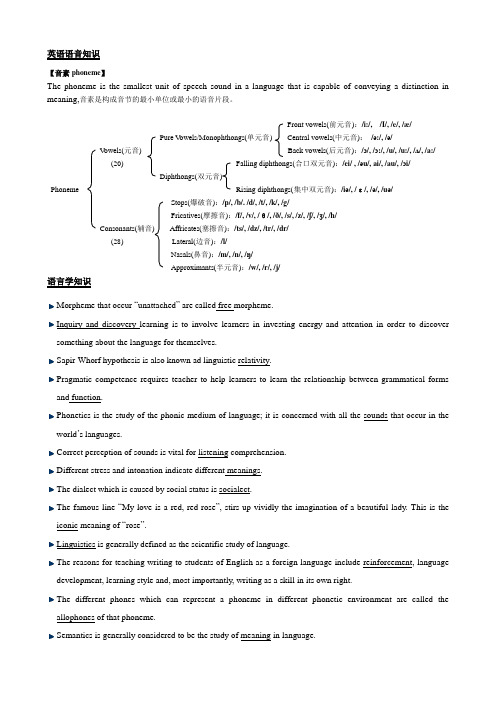
英语语音知识【音素phoneme】The phoneme is the smallest unit of speech sound in a language that is capable of conveying a distinction in meaning,音素是构成音节的最小单位或最小的语音片段。
Front vowels(前元音):/i:/, /I/, /e/, /æ/Pure V owels/Monophthongs(单元音) Central vowels(中元音):/ə:/, /ə/V owels(元音) Back vowels(后元音):/ɔ/, /ɔ:/, /u/, /u:/, /ʌ/, /a:/(20) Falling diphthongs(合口双元音):/ei/ , /əu/, ai/, /au/, /ɔi/Diphthongs(双元音)Phoneme Rising diphthongs(集中双元音):/iə/, /ε/, /ə/, /uə/Stops(爆破音):/p/, /b/. /d/, /t/, /k/, /g/Fricatives(摩擦音):/f/, /v/, /θ/, /ð/, /s/, /z/, /ʃ/, /ʒ/, /h/Consonants(辅音) Affricates(塞擦音):/ts/, /dz/, /tr/, /dr/(28) Lateral(边音):/l/Nasals(鼻音):/m/, /n/, /ŋ/Approximants(半元音):/w/, /r/, /j/语言学知识Morpheme that occur “unattached” are called free morpheme.Inquiry and discovery learning is to involve learners in investing energy and attention in order to discoversomething about the language for themselves.Sapir-Whorf hypothesis is also known ad linguistic relativity.Pragmatic competence requires teacher to help learners to learn the relationship between grammatical formsand function.Phonetics is the study of the phonic medium of language; it is concerned with all the sounds that occur in theworld’s languages.Correct perception of sounds is vital for listening comprehension.Different stress and intonation indicate different meanings.The dialect which is caused by social status is socialect.The famous line “My love is a red, red rose”, stirs up vividly the imagination of a beautiful lady. This is theiconic meaning of “rose”.Linguistics is generally defined as the scientific study of language.The reasons for teaching writing to students of English as a foreign language include reinforcement, languagedevelopment, learning style and, most importantly, writing as a skill in its own right.The different phones which can represent a phoneme in different phonetic environment are called theallophones of that phoneme.Semantics is generally considered to be the study of meaning in language.。
- 1、下载文档前请自行甄别文档内容的完整性,平台不提供额外的编辑、内容补充、找答案等附加服务。
- 2、"仅部分预览"的文档,不可在线预览部分如存在完整性等问题,可反馈申请退款(可完整预览的文档不适用该条件!)。
- 3、如文档侵犯您的权益,请联系客服反馈,我们会尽快为您处理(人工客服工作时间:9:00-18:30)。
英语语音知识
【音素phoneme】
The phoneme is the smallest unit of speech sound in a language that is capable of conveying a distinction in meaning,音素是构成音节的最小单位或最小的语音片段。
Front vowels(前元音):/i:/, /I/, /e/, /æ/
Pure V owels/Monophthongs(单元音) Central vowels(中元音):/ə:/, /ə/
V owels(元音) Back vowels(后元音):/ɔ/, /ɔ:/, /u/, /u:/, /ʌ/, /a:/
(20) Falling diphthongs(合口双元音):/ei/ , /əu/, ai/, /au/, /ɔi/
Diphthongs(双元音)
Phoneme Rising diphthongs(集中双元音):/iə/, /ε/, /ə/, /uə/
Stops(爆破音):/p/, /b/. /d/, /t/, /k/, /g/
Fricatives(摩擦音):/f/, /v/, /θ/, /ð/, /s/, /z/, /ʃ/, /ʒ/, /h/
Consonants(辅音) Affricates(塞擦音):/ts/, /dz/, /tr/, /dr/
(28) Lateral(边音):/l/
Nasals(鼻音):/m/, /n/, /ŋ/
Approximants(半元音):/w/, /r/, /j/
语言学知识
Morpheme that occur “unattached” are called free morpheme.
Inquiry and discovery learning is to involve learners in investing energy and attention in order to discover
something about the language for themselves.
Sapir-Whorf hypothesis is also known ad linguistic relativity.
Pragmatic competence requires teacher to help learners to learn the relationship between grammatical forms
and function.
Phonetics is the study of the phonic medium of language; it is concerned with all the sounds that occur in the
world’s languages.
Correct perception of sounds is vital for listening comprehension.
Different stress and intonation indicate different meanings.
The dialect which is caused by social status is socialect.
The famous line “My love is a red, red rose”, stirs up vividly the imagination of a beautiful lady. This is the
iconic meaning of “rose”.
Linguistics is generally defined as the scientific study of language.
The reasons for teaching writing to students of English as a foreign language include reinforcement, language
development, learning style and, most importantly, writing as a skill in its own right.
The different phones which can represent a phoneme in different phonetic environment are called the
allophones of that phoneme.
Semantics is generally considered to be the study of meaning in language.。
